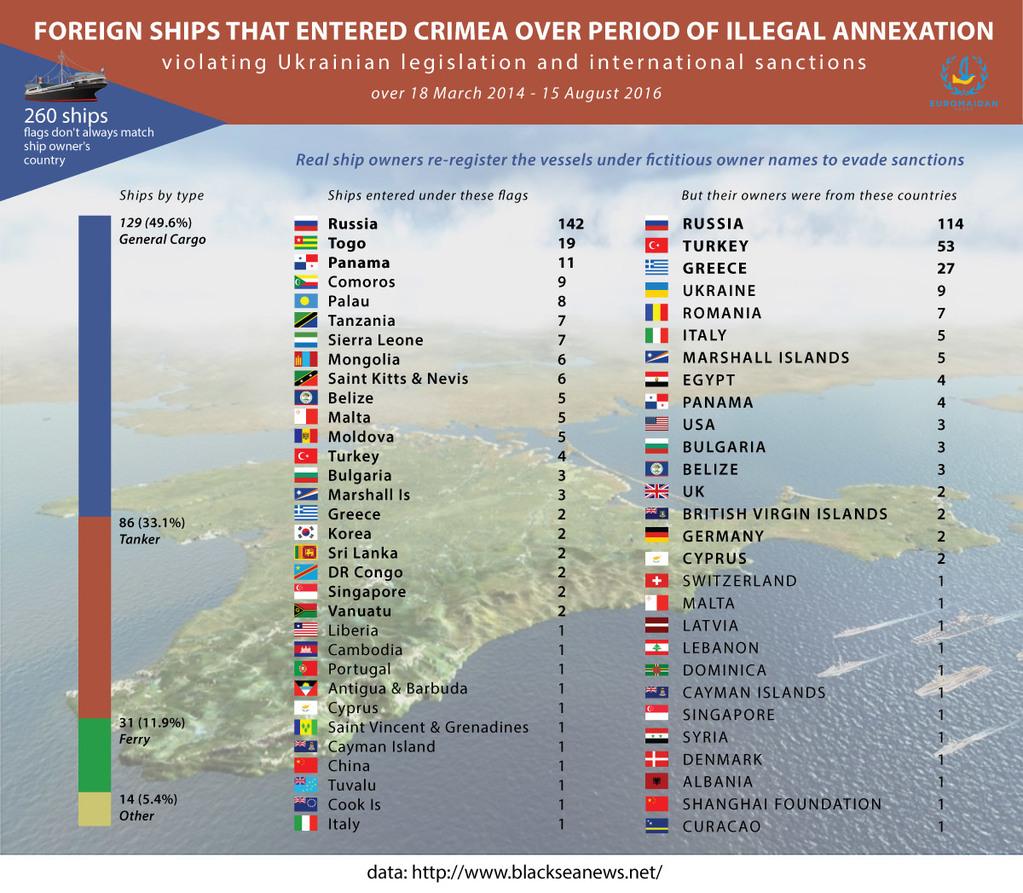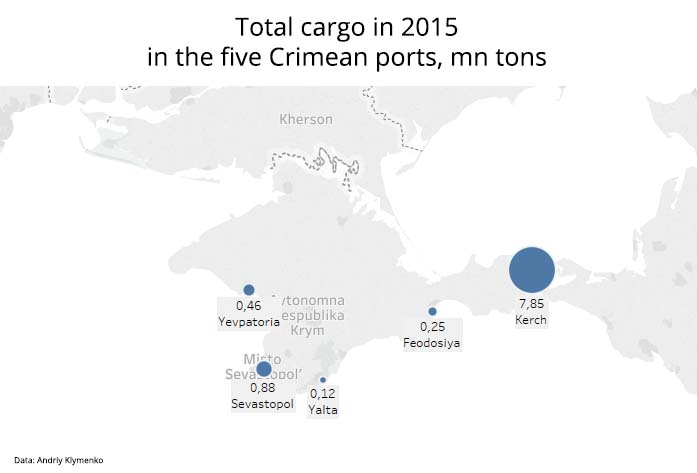As many as 260 ships have violating Ukrainian law and international sanctions by docking at the ports of occupied Crimea.
After Russia illegally annexed the Ukrainian peninsula, Ukraine closed it to international navigation on 16 June 2014. Subsequently, the EU and US also banned entrance into Crimean ports and imposed corresponding sanctions. However, foreign ships are finding their way to the peninsula.
However, a list published by Black Sea News shows this didn’t stop some merchant vessels. The portal had been monitoring ship data from shippingexplorer.net on a daily basis during 18 March 2014 – 15 August 2016. 260 merchant ships flying 32 different flags that in violation of the sanctions have docked at Crimean ports have made it to the black list.

The ships coming in mostly fly the usual “flags of convenience,” which not always represent the country of the ship’s owner or its managers. Finding out who is behind the ship is a difficult process – Black Sea News informed that real ship owners, especially from abroad, re-register the vessels under the fictitious owners’ names and regularly change operating companies in order to evade sanctions.
Additionally, the vessels often change flags. 23% of the 260 ships have changed the flag they were initially registered under when first put on the black list in 2014-15.
Black Sea News’ data reveals that Russia, Türkiye, and Greece are the top-3 countries violating the sanctions regime in Crimea. Ukrainian, Romanian, and Italian ships were also among top offenders. Altogether, the 260 ships belonged to owners from 28 countries.
Turning off radars to avoid being tracked
How do the ships manage to enter Crimean ports without being noticed? An investigation by OCCRP tracked a ship named General under the flag of Palau that deviated from its planned route to Kherson, mainland Ukraine. Near the shores of occupied Crimea it disappeared from the radars. This means that the crew turned off its AIS navigation system, allowing to locate the ship by sattelite. On 9-15 December 2015, local residents observed how the ship was loading scrap metal, in violation of international prohibitions.
The journalists said that many vessels use this method, despite the risks for getting into an accident.
OCCRP counted more than 600 law-breaking ships. However, Andriy Klymenko, chief editor of Black Sea News, claims that number includes vessels that technically were not violating sanctions. The list of 260 vessels excludes vessels that belonged to Ukraine but were “nationalized” by Russia, ships that that docked for repairs in Crimea at the start of Russian occupation, yachts, Crimea’s fishing fleet and others.
Despite the violator ships, sanctions are working
In an interview to investigator.org.ua, Andriy Klymenko said that despite the list that his outlet published, Ukrainian and international sanctions applied with regards to the annexation of Crimea, are working: in 2014, Russian ships accounted for 45.2% of marine traffic to Crimea. In 2016, that number has risen to 70.6%.
“This means that vessels of civilized countries under civilized flags and with civilized owners stopped entering Crimea. In result, there is a large deficit of marine vessels,” Andriy explains. He goes on to state that the civic blockade of Crimea, which has been going on for a year, made shipping the main way to transport passengers and freight loads into occupied Crimea. “In my opinion, retaining sanctions and extending them onto those who violate them today is a major task of civil society and international diplomacy,” the expert noted.

Scrap metal and grain are the main exports of Crimea
According to the monitoring results, Crimea now exports chiefly scrap metal and grain, Andriy Klymenko told. Grain is exported by Egyptian, Syrian, partially Greek and Turkish ship owners from Sevastopol and Kerch to North Cyprus, Syria, Libya, and sometimes to Egypt. But scrap metal is the main export. A dozen of Turkish and Romanian ships now transports it out the ship gravezard of Sevastopol’s Inkerman.

The only port whose cargo turnover is rising is Kerch, where 21 ferries operate to connect the occupied peninsula with Russia. Russia’s plans to build a bridge to connect the illegally annexed territory have so far been without results.





